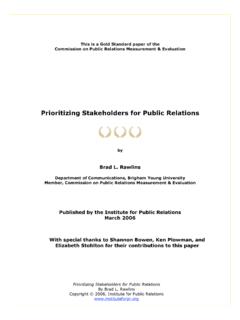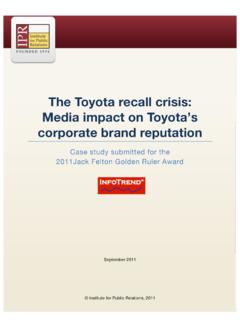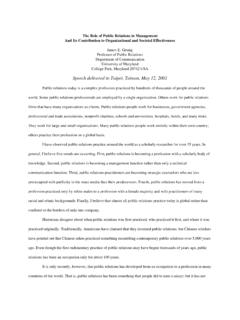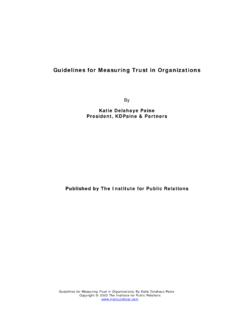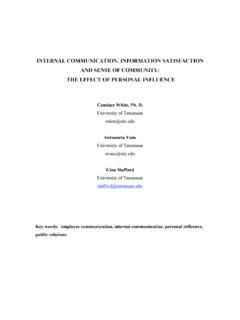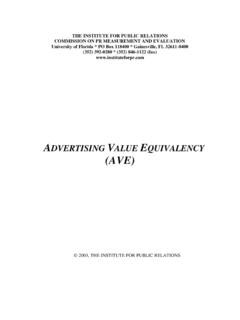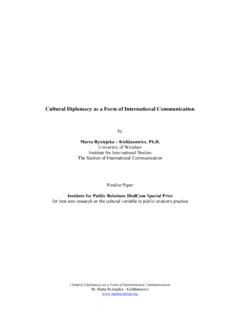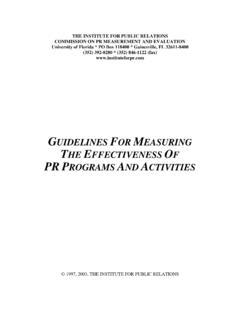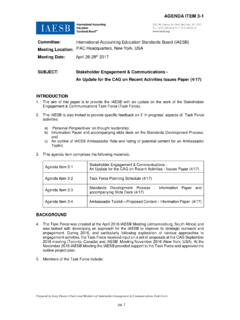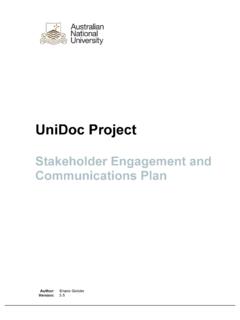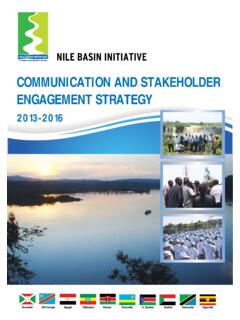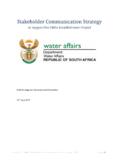Transcription of Understanding Stakeholder Engagement: Faith-holders ...
1 1 Understanding Stakeholder engagement : Faith-holders , Hateholders & Fakeholders Vilma Luoma-aho Professor of Organizational Communication & Public Relations Department of Communication University of Jyv skyl PO Box 35 (OPK), FIN 40014 * Tel. +358 40 8053 098 @vilmaluo Research Journal of the Institute for Public Relations Vol. 2, No. 1 (Winter, 2015) Institute for Public Relations 2 Abstract Stakeholder engagement has risen on the agenda of public relations recently mostly due to the introduction of real-time media and new hybrid forms of marketing, advertising and public relations. Engaging stakeholders is not a simple task in the information rich environment, and can be compared to a pinball match; organizational messages now have direct access, but often bounce randomly around in the online environment. To simplify measurement of public relations in this complex, unpredictable environment, this article distinguishes between three different types of Stakeholder relationships: the positively engaged Faith-holders , the negatively engaged hateholders, and fakeholders the unauthentic persona produced by astroturf and algorithms.
2 The paper suggests that it is the future task of public relations professionals to support the Faith-holders , engage the hateholders and reveal the fakeholders. This mostly conceptual article introduces these three emerging groups, gives examples of all three and ponders their significance and their implications for public relations in the future. Research Journal of the Institute for Public Relations Vol. 2, No. 1 (Winter, 2015) Institute for Public Relations 3 Executive Summary Understanding Stakeholder engagement : Faith-holders , Hateholders & Fakeholders Vilma Luoma-aho Stakeholder engagement has always been central for public relations, but has received more attention recently due to the introduction of real-time media and new hybrid forms of marketing, advertising and public relations. Engaging stakeholders is not a simple task in the information rich environment, and can be compared to a pinball match; organizational messages now have direct access, but often bounce randomly around in the online environment.
3 To simplify measurement of engagement in public relations in this complex, unpredictable environment, this article distinguishes between three different types of Stakeholder relationships: the positively engaged Faith-holders , the negatively engaged hateholders, and fakeholders the unauthentic persona produced by astroturf and algorithms. This mostly conceptual article introduces these three emerging groups, gives examples of all three and ponders their significance and their implications for public relations in the future. Four propositions are presented: 1) Priority in Stakeholder relations should be placed on the Faith-holders of high trust and long-term commitment, as they further influence all other stakeholders. In practice, this will mean slowly redirecting organizational finances and efforts from the previously prevailing focus on crisis management and dealing with Hateholder interactions toward support and service desired by the Faith-holders . 2) Hateholders should not be ignored but seen as a potential future faith - holder group if their issues are addressed.
4 More research is needed to understand how the in process of reconciliation would occur practice, but Understanding that hate may not be the final emotion these stakeholders feel toward the organization will encourage professionals. 3) Public relations should monitor the Stakeholder arenas to detect possible fakeholders, and if detected, invite the hidden influencer to dialogue. This remains an ideal, as in there are always hateholders and fakeholders that cannot be reasoned with. 4) All stakeholders may move from positive to negative engagement or from negative to positive engagement unexpectedly. Static maps of Stakeholder emotion are outdated and need to be replaced with dynamic, realtime Understanding of how stakeholders feel. The paper suggests that it is the future task of public relations professionals to support the Faith-holders , engage the hateholders and reveal the fakeholders. Understanding all three groups is needed, as they all contribute to organizational legitimacy.
5 Research Journal of the Institute for Public Relations Vol. 2, No. 1 (Winter, 2015) Institute for Public Relations 4 Introduction Stakeholder engagement has risen on the agenda of public relations recently mostly due to the introduction of social media and new forms of contribution media (Castells, 2009). How stakeholders engage with brands and organizations matters in this environment where peers and people just like me have become the most trusted sources for information and experiences both online and offline (Edelman, 2013). Engaging stakeholders is not a simple task in the information rich environment, and can be compared to a pinball match; organizational messages now have direct access, but often bounce randomly around in the online environment (Hennig-Thuray et al. 2010). At the world public relations forum in Madrid, Spain in September 2014, Paul Holmes of the Holmesreport suggested that public relations measurement in essence was about which stakeholders can recommend us, and which are harmful.
6 This article elaborates on that idea by introducing three different Stakeholder groups in regards to the timely topic of Stakeholder engagement . The Melbourne Mandate (2012) views Stakeholder engagement as central for sustaining positive organization-public relationships. Though some scholars prefer to talk of publics (Aldoory & Grunig, 2012) instead of stakeholders , mutual dependence remains the central idea. According to the situational theory of publics (Grunig & Huang, 2000), different groups become active or latent depending on their interest in the issue. In the online environment such changes may occur almost in real-time, and problem recognition, constraint recognition and level of involvement may all change unexpectedly. In fact, publics and stakeholders not previously understood to be of importance for organizations and issues may be activated through third parties and the media, and complicate the traditional Understanding of who matters and why for organizations (Luoma-aho & Paloviita, 2010).
7 Research Journal of the Institute for Public Relations Vol. 2, No. 1 (Winter, 2015) Institute for Public Relations 5 Organizations have been established as targets of strong emotions ranging from hate to love and even passion (Fineman, 1993). Stakeholders in general tend to expect greater engagement than before, and the feeling rules (Hochschild, 1979) about what feeling is or is not appropriate to a given social setting are constantly re-negotiated online. Trust toward the organization and inside the organization (Kramer & Tyler 1996) is central in this era when organizations aim to deal with public displays of positive and negative emotion. Trust is believed to be the foundation of a strong organizational character that all communication is built on. For many organizations customers and stakeholders are resources to be utilized. This thinking, however, is becoming outdated when these resources have actual access into publishing their experiences to potentially large audiences.
8 engagement as a construct brings the relationship between stakeholders and organizations on a more equal level: brands and organizations have to interact with stakeholders on various issue arenas (Luoma-aho & Vos, 2010) or rhetoric arenas (Coombs & Holladay, 2013) outside their control. As engagement becomes the trend, there is a shift toward seeing stakeholders as long-term assets to be protected and cultivated. Management of these emerging relationships, however, has become challenging in the era not dominated by organizations. engagement cannot be forced, and the ideal is to tempt stakeholders into a relationship through providing extra value and contributing to issues relevant to them. The value of engagement lies in its Understanding of dialogue dynamics and enabled participation. Beyond public relations, several other related traditions and disciplines have taken interest in Stakeholder engagement including advertising (Wang 2006), environmental management (Amaeshi & Crane, 2006), marketing (Brodie et al.)
9 2011) and in the form of reader engagement , even online journalism (Mersey et al. 2009). What all these disciplines agree on, Research Journal of the Institute for Public Relations Vol. 2, No. 1 (Winter, 2015) Institute for Public Relations 6 however, is the new emphasis on the importance of dialogic nature of the relationship between stakeholders and organizations (DuMars, Sitkiewicz & Fogel 2010). In general, engagement refers to the level of interaction a Stakeholder shows toward an organization, and this interaction is believed to influence Stakeholder thoughts, actions and emotions toward the organization (Brodie, Hollebeek, Juric & Ilic, 2011). In the age of poly-contextual corporate legitimacy (Holmstrom, 2004) where organizations and brands must increasingly negotiate their licence to exist with various different Stakeholder groups on different issue arenas of influence (Luoma-aho & Vos, 2010), the role stakeholders play for organizational survival can be seen to have increased.
10 In this unpredictable environment organizations often look for Stakeholder support, yet simultaneously have to prepare for opposition (McDonald & Cokley, 2013). It is an environment of increased Stakeholder power and emotion, and new forms of stakeholding can be distinguished: the positively engaged authentic Faith-holders and the negatively engaged hateholders. As portrayed in figure 1, the logic behind these is that organizational legitimacy can only be maintained in the long term if the number of Faith-holders exceeds the number of hateholders (author, 2010). Research Journal of the Institute for Public Relations Vol. 2, No. 1 (Winter, 2015) Institute for Public Relations 7 Figure 1. The division of Faith-holders and hateholders and consequences to organizational legitimacy. This article also introduces and the emerging astroturfed unauthentic fakeholders, that matter especially during times of challenged legitimacy. On issue arenas, sometimes all three groups are equal, and traditional modes of relationship cultivation and building do not work.
